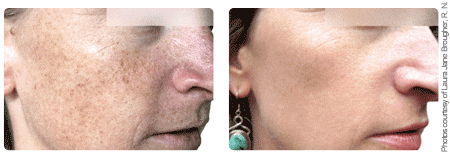Intense Pulsed Light Treatments

IPL treatments for pigmentary lesions received FDA clearance in 1995. Since then multiple studies were published attesting to the effectiveness of this therapy for the treatment of “brown spots”, vascular lesions, acne, premalignant disorders and other dermatologisc disorders.
The most common types of pigmentary lesions which showed good response were the solar lentigines, ephelides (freckles), lentiginous disease in Asians, and lentigines associated with Peutz-Jeghers Syndrome.
In melasma IPL shows moderate efficiency. It is, however, advisable to add a triple combination (cream fluocinolone acetonide, hydroquinone, tretinoin) and even use an ablative laser in cases of resistant pigment.
The results were achieved with 3 to 5 treatments. Histologic analysis showed an increase in fibroblasts, and increased thickening and density of collagen fibers, consistent with collagen remodeling. This explains the improvement in appearance, skin texture and tightening which are often seen with these treatments.
Other pigmetary conditions showing response are: nevus spilus, café-au-lait macule, and postinflammatory hyperpigmentation,
Acne is another condition which showed good response to treatment with IPL. These treatments decrease redness, irregular pigmentation and improve skin tone.
The addition of aminolevulinic acid showed better results in cases of inflammatory acne.
Multiple light sources, like blue light and IPL showed a decrease in acne flares with excellent results in acne vulgaris particularly in those patients who are intolerant to oral antibiotics and retinoids.
Rosacea can be effectively treated with IPL with decrease in the erythema (redness) and telangiectasia (enlarged capillaries). Response to this therapy can be improved by the addition of other medical treatments: low dose antibiotics or topicals like metronidazole or azelaic acid.
Actinic Keratosis treated with IPL alone or combined with methyl-aminolevulinate shows good results. The addition of blue light to IPL and the levulinic acid was superior in some studied to IPL alone.
Other indications for IPL include: hypertrophic erythematous scars and sebaceous gland hyperplasia, as well as other less common inflammatory diseases.
The adverse effects noticed were, redness, mild discomfort, swelling, blistering and crusting. Most of these findings resolve within 24-48 hours, rarely lasting up to one week. Post treatment hypo- or hyper pigmentation were also noted.
Overall the adverse effects were temporary and could be treated with simple conservative protocols. Severe reactions were very rare.
If you have any questions regarding treatment with IPL for any of these conditions: acne, rosacea, actinic keratosis, or lentigines call us at 914-730-2005.